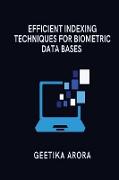- Start
- Efficient Indexing Techniques for Biometric Databases
Efficient Indexing Techniques for Biometric Databases
Angebote / Angebote:
Efficient indexing techniques for biometric databases refer to a set of methods and algorithms that enable fast and accurate search of large-scale biometric datasets. Biometric data refers to any measurable biological characteristic or behavioral trait that can be used for identification purposes, such as fingerprints, facial features, voice patterns, or gait. Biometric databases are used in various applications, such as border control, law enforcement, access control, and e-commerce.
Efficient indexing techniques aim to address the challenges of handling and searching large volumes of biometric data in real-time. These techniques typically involve extracting relevant features from the biometric data and creating an index structure that enables efficient search and retrieval of data. Various indexing techniques have been proposed for biometric databases, including hash-based indexing, tree-based indexing, inverted indexing, and clustering-based indexing.
In addition to the index structure, efficient indexing techniques also involve the use of similarity measures, query optimization, and performance evaluation. Similarity measures are used to compare the query biometric data with the stored data in the database, while query optimization is used to optimize the search process and reduce the response time. Performance evaluation is used to assess the efficiency and effectiveness of the indexing techniques and to identify areas for improvement.
Efficient indexing techniques for biometric databases are essential for ensuring fast and accurate identification and verification of individuals in various applications. These techniques are also critical for ensuring the privacy and security of biometric data by minimizing the risk of unauthorized access and misuse.
Fremdlagertitel. Lieferzeit unbestimmt
